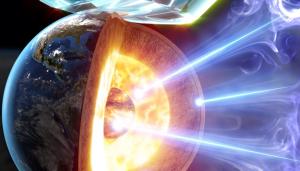LAB REPORT
Science and Technology Making Headlines
March 6, 2015


Geochemist Roger Aines and Lawrence Livermore colleagues have created a new type of carbon capture technology using silicone microcapsules and a baking soda solution. In this photo, Aines examines a small pile of these microcapsules sitting on a quarter. Photo by John Vericella/LLNL
Tiny bubbles in the air
Carbon capture and storage could be one of the solutions to the world’s fossil fuel greenhouse gas problems. Absorbing CO2 from smokestacks and burying it underground is feasible, but it's expensive and difficult, largely due to the carbon capture process, which uses caustic chemicals and consumes a lot of energy.
Roger Aines, leader of the Carbon Management program at Lawrence Livermore, and his colleagues, have developed a new carbon capture technique using tiny silicone capsules that look like bubbles, filled with what is essentially baking soda. Those capsules would be placed in the flue of a power plant where they would work to capture CO2.
These "microcapsules" are easy to handle, recyclable and should be a much more energy-efficient way to scrub carbon dioxide from fossil fuel power plant than traditional methods.


Lawrence Livermore Engineer Sat Pannu and his Neural Tech Group research team are developing wireless electronic packages that would contain electronics that record and stimulate the peripheral nervous system to control movement and sensation in a patient’s prosthetic hand.
Do you feel me?
Prosthetic arms that can communicate with the brain and feel sensation are under development at Lawrence Livermore and five years away from human testing.
Researchers are working on re-creating sensations that many take for granted: to feel the skin of a significant other, the texture of a fine linen or the cool water of a babbling brook. The arm, and its connection to the nervous system, would be nothing short of a miracle for thousands of veterans who have returned from war with missing limbs.
"It would be a life-changing event," said Sat Pannu, director of the Center for Bioengineering at Lawrence Livermore, one of eight teams nationwide working to develop the arm. "Quite literally, it would be a real biological replacement of their arm."


This artist’s illustration shows a planetary scale impact on the moon. Illustration by W.K. Hartmann.
Getting to the core
By recreating the violent conditions of Earth’s formation, scientists are learning more about how iron vaporizes and how it affects the formation of the Earth and moon.
Scientists from Lawrence Livermore, Sandia National Laboratory, Harvard University and UC Davis used Sandia’s Z-machine to re-create conditions that led to Earth’s formation. They subjected iron samples to high shock pressures in the machine, slamming aluminum plates into iron samples at extremely high speeds. They developed a new shock-wave technique to determine the critical impact conditions needed to vaporize the iron.
The results show that iron vaporizes easily during impact events, which forces planetary scientists to change how they think about the growth of planets and evolution of our solar system.


GigaShot installed at LLNL
ELI pumps it up
One of the key components of a future beamline destined for the Extreme Light Infrastructure (ELI) facility in Prague has been assembled at Lawrence Livermore National Laboratory.
LLNL is a key partner in the giant ELI project, specifically the high-repetition-rate advanced petawatt laser system (HAPLS).
Engineers from LLNL and the Northrop Grumman subsidiary Cutting Edge Optronics have just installed the main pump source for HAPLS. The injection-seeded, diode-pump "GigaShot-HE" laser is capable of generating two Joule pulses with duration of less than 10 nanoseconds. In the completed system, Ti:sapphire amplifiers will convert those pulses into the petawatt power regime.


Dick Post has worked for LLNL for 63 years.
A league of his own
He was born three days after the World War I armistice and at 96 he still is going strong.
Lawrence Livermore chief scientist Dick Post is working on the storage of energy with specially designed flywheels, one of his many passions. He was recently interviewed by former U.S. Sen. Bill Bradley on his Sirius XM radio show “American Voices.”
Post discussed many of his important technology projects including the magnetic levitation train system, flywheel battery storage and passive magnet bearings.
Post is part of the 1 percent of the workforce 75 and older that are still working. He commutes four days a week and has worked at the Lab for 63 years.





